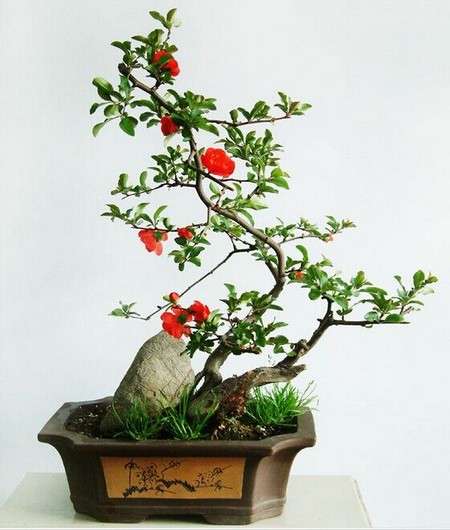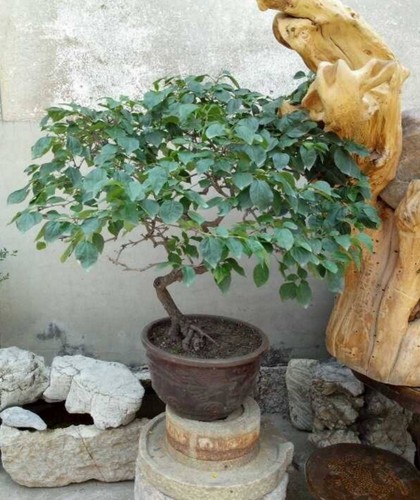The method of making bonsai of rose
Rose known as "queen of flowers" reputation, its colorful, graceful and graceful, in addition to potted, ground ornamental and cut flowers, but also can make bonsai. The root of the rose is dry and simple, and in early spring it is full of new buds and leaves or red or green, fresh and pleasant, giving people a sense of vitality; from late spring to autumn, the flowers are full of branches and smell fragrant, even in winter, its vigorous and handsome branches are also quite enjoyable, and they are rich in resources and easy to obtain, so they are promising bonsai materials. A well-made and vivid rose bonsai is a very infectious work of art.

The key to making large-scale rose bonsai is to master the following key points:
1. Pile mining: Qiang Wei pile with peculiar type and natural tip is dug on the side of hillside and ditch every spring. After the pile is harvested, the root trunk is cut in place as far as possible and planted with a little sawdust infiltrated with plain sandy soil. Pot can be planted on the ground, the whole set of plastic bags, after the new buds grow 3cm-5cm, choose rainy days to remove the plastic bags, and then every morning and evening to dry, leaves spray water to ensure survival. Fertilization can be started in August, once every half month, with cake fertilizer and water as the best. The branch transition is natural, the next spring to prune, strengthen management, and so on when the new branches grow to a certain thickness, you can start grafting. Individuals who need to be dried can continue to be stocked.
2. Grafting: it is better to adopt bud grafting in rose bonsai grafting, which is characterized by simple operation, long grafting time, bud grafting from May to September and high survival rate. Visible personal hobbies, choose grafted rose colors and varieties. However, according to my practical experience, it is considered that miniature rose has the characteristics of short plant, small and exquisite flowers, large number of flowers and long florescence, so it is the first choice for grafting. Miniature rose varieties with similar flower patterns can be selected for grafting.
Rose grafting is not difficult, but in order to achieve a higher survival rate, three links must be mastered:
One is to select buds. The buds must be taken from strong branches, and it is best to wait until they are about to sprout. It is best to cut off the flowers and fertilize them, release them for a week, and take buds for grafting when the buds begin to sprout.
The second is to sprout. The common rose adopts the method of peeling and taking buds, and the micro rose branches are thin, so it is not easy to take buds according to the traditional method. We should first cut the shoots close to 2cm length, cut obliquely from the middle part of the back of the bud to both ends, then peel off the cortex from the lower end of the bud, slowly peel off the xylem, and be sure to protect the vascular bundles in the bud. After the bud is removed, according to the high change of the incision of the rootstock, cut the two ends of the bud slice, gently put into the incision of the rootstock, and close to the xylem of the rootstock, wrap it tightly with plastic strips to expose the bud eyes.
The third is moisturizing. After the completion of grafting and bandaging, the grafted rose bonsai can be put into a plastic greenhouse for maintenance if possible, or a single branch can be used to cover plastic bags, which can be directly placed in the natural environment for maintenance. 7Mill can remove the plastic bags in 10 days, untie them, and make up according to the survival situation.
The selected rose is a deciduous shrub of Rosaceae, which has many kinds of flowers, such as white, pink, red, yellow, purple, orange, light green, complex color, etc., and there are many changes in flower shape and flower size. The rose used to make bonsai requires bright flowering, easy flowering, compact plant type, short nodes, small leaves, strong habits, strong germination, resistance to pruning, and flower color and pattern can be chosen according to personal preferences. The propagation cuttage method is mainly cuttage, which can not only cut the tender wood cuttings of the same year after the flower blossoms in May, but also use hardwood cuttings in combination with pruning in October.
Those old roses that have grown for many years and have a quaint and strange shape that have been eliminated in landscaping can also be used to make bonsai, generally transplanting in winter and spring, and in the south because of high air humidity, they can also be transplanted in summer and autumn, first planted in tile pots or underground. As the main root of rose is well developed and the lateral root is rare, the overlong main root should be cut short before planting, and more lateral root and fibrous root should be retained. Planting should be deep, and it is best to bury all the roots in the soil to ensure survival. After planting, keep the soil moist without stagnant water, erase the new shoots that are not needed in modeling after survival, and strengthen the management of water and fertilizer to promote the healthy growth of branches.
Can also use those who grow for many years, stem Qiu qu colorful rose (commonly known as "thorn plum"), wood incense and other rose plants of the old pile as rootstocks, with 'big medal', 'scarlet fan', 'Huang Heping', 'cocktail', 'Caiyun' and other varieties with easy flowering, strong growth or miniature rose with small leaves and exquisite flowers as scions, it will be combined into one by the method of grafting, which will be used to make bonsai. Bud grafting is usually used from June to September, dormant period is carried out by splicing method, and tender shoots can be spliced or ventrally grafted according to different climatic characteristics and specific conditions. When grafting, we should pay attention to the height and direction of the bud, and sometimes several rose varieties of different colors and patterns can be grafted on a rose or rose stump. The flowers of different colors compete with each other when they bloom, which is very beautiful.
There are mainly three types of rose bonsai: ancient pile rose bonsai, miniature rose bonsai and combined rose bonsai. Its modelling mainly has the single dry type, a double dry type, the curved dry type, the oblique dry type, the facing water type, the cliff type, the exposed root type, the dry type, the attached stone type, the jungle type, the water drought type, the big tree type and so on different forms, and according to the modeling need, put forward the soil surface of the root, make it hang the root to reveal the claw, simple and vigorous. Root lifting should be carried out one by one, not too much at a time, so as not to cause the stump to sprout and die. Due to the strong upright branches and large leaves of rose, the crown is generally in natural shape. The modeling method is mainly pruning, supplemented by pulling, so that the branch layout is reasonable, high and low, because its branches are brittle, easy to break, the skin is also easy to tear, so do not bend flat tie.
Several robust rose plants are planted in rectangular or oval flowerpots of appropriate size to make "co-planted rose bonsai" or "dry rose bonsai". When planting, pay attention to the collocation of the flowers and colors of each rose and the coordination of flowers, stems and leaves, so as to achieve the harmony between positive and oblique, dynamic and static, skillful and clumsy, hidden and dew. finally, it is equipped with spirit stone, trees or other flowers and moss to make it poetic and picturesque.
The made rose bonsai can be covered with moss, planted with grass, and put some strange stones or other accessories to make it more vivid.
Potting step
1. Dig out the rose that is buried in the seedbed and planted in a small pot, and trim it properly to cut off the branches that are not needed for modeling.
2. Choose a rectangular marble shallow pot, because the flowerpot is shallow and the amount of water evaporates quickly, it will not cause stagnant water, so there is no need to have a drainage hole at the bottom of the basin.
3. Move the rose to the marble shallow basin and pay attention to the position of the plant in the basin when planting to make it harmonious and natural.
4. Cut off the excessively long root system, and then arrange stones around the soil to make the foot of the slope to increase the wild interest.
5. After the completion of the rose bonsai, the flowerpot can be buried in the seedbed, sand bed or larger tile basin for maintenance, so as to facilitate management.
6. after flowering, dig the flowerpot out of the seedbed, scrub the soil off the pot, match it with several suitable frames, and decorate the bonsai furnishings such as boats and characters to make it more vivid and interesting.
Time: 2019-05-26 Click:
- Prev

The method of making miniature camellia bonsai
Put a few pots of camellias in the bedroom, can decorate the environment more elegant, in order to increase the interest of life. Potted camellias will have higher ornamental value if they are modeled and planted in a suitable bonsai. When making camellia bonsai at home, the plants should not be too large. It is better to make miniature bonsai and small and medium-sized bonsai.
- Next

The method of making lilac bonsai
A shrub or small tree of the genus Syringa, up to 5 m tall; bark grayish brown or gray. Branchlets, inflorescence rachis, pedicels, bracts, calyx, both sides of young leaves and petiole are glabrous and densely covered with glandular hairs. Branchlets thicker, sparsely lenticellate. Leaf blade leathery or thickly papery, ovoid to reniform, panicle erect, drawn from lateral buds
Related
- Fuxing push coffee new agricultural production and marketing class: lack of small-scale processing plants
- Jujube rice field leisure farm deep ploughing Yilan for five years to create a space for organic food and play
- Nongyu Farm-A trial of organic papaya for brave women with advanced technology
- Four points for attention in the prevention and control of diseases and insect pests of edible fungi
- How to add nutrient solution to Edible Fungi
- Is there any good way to control edible fungus mites?
- Open Inoculation Technology of Edible Fungi
- Is there any clever way to use fertilizer for edible fungus in winter?
- What agents are used to kill the pathogens of edible fungi in the mushroom shed?
- Rapid drying of Edible Fungi

